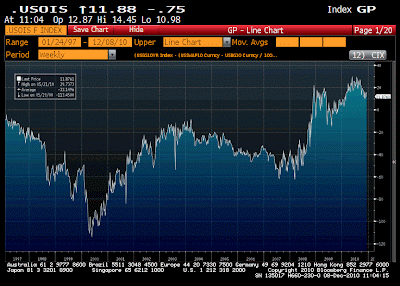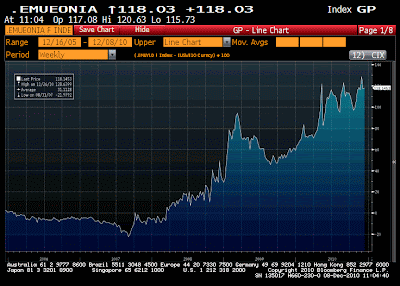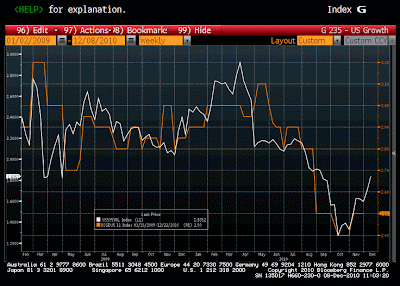


http://macro-man.blogspot.com/ 大趋势是有机的量子态,集体态,很多自由度组成,相对不易分解和定价;a+b=a+ab+ba+b,not 正交, can't be 容易被分解和投影,定价 短期投机容易被分解和投影,定价;a+b=a+b, a & b 正交 Bad day for Goldfinger, but worse for Mr Bond Wednesday, December 08, 2010 Well, TMM were happy with yesterday's Gold move, but they are sure they are not alone in cringing at the car crash that has occurred in the Treasury & FX markets overnight as Tens smashed through 3% and then proceeded to trade as low as 3.25% on the London open. Cue a barrage of excitable emails, Bloomberg messages and IBs from all corners of the market, intellectualising about how the Treasury move shows that the market is now worried about the sustainability of the US debt load, or that equities cannot rally with yields moving higher, or that QE2 has failed, or that mortgage convexity selling is about to send yields to 3.5% etc etc... Usually, TMM's "signal" for when things have gotten a bit overdone is when emails on rather complex subjects start to come from single stock equity guys or the FX market... we'll merely refer you to our Armchair Generals piece. But in seriousness, TMM have a hard time buying a lot of these arguments and we will attempt to explain why. In terms of debt sustainability, in our view, looking at US sovereign CDS is not particularly useful, given that US banks cannot trade it and given that most hedge funds have US banks as their prime brokers, there is little point in them trading such instruments, and as such, it is rather illiquid. However, the Treasury market and Overnight Indexed Swap (OIS) markets are very liquid. Now TMM is totally open to the idea that the US is the next "obvious" candidate for the bond market vigilantes to target, it is pretty hard to do so when Voldemort & his Deatheaters and the Fed are on the bid. And the former doesn't have any other obvious candidates given the Eurozone train wreck and the latter will buy until growth and inflation are back to "normal" levels. But back to the UST/OIS markets. A much better way of observing (and trading) the pressure on the US fiscal position is to look at the 10yr UST-OIS Swap Spread, as the latter is a much better proxy for the "real" risk free rate (usual caveats apply, but it's pretty close) - see chart below. It's pretty clear that the rates sell-off is not related to fiscal concerns. And as far as TMM can tell, at around 12bps, there is no particular concern evident here, and we are well-off the wides of ~30bps earlier in the year. Clearly the financial crisis has taken its toll, with the measure no longer trading negative due to the premium they have had as a result of the USD being the reserve currency, but we are nowhere near the kind of levels that the equivalent Eurozone spread is trading at. The below chart shows the GDP-weighted EMU yield vs EONIA, and even though this measure includes the King of fiscal prudence, Germany, at 118bps the debt sustainability concerns are very clear: But what about growth prospects? Obviously, payrolls excepted, the US economic data has generally surprised to the upside over the past month or so and the Vampire Squid (amongst others) have revised up their 2011 growth forecasts significantly. TMM like to look at the 5y5y forward real rate as a market proxy for future growth, and the below chart (white line - 5y5y forward real rate, orange line - consensus economist 2011 GDP forecast, lagged two months) seems to indicate that the bond market has revised up its view of GDP to close to 2.7%. With 5yr real rates still negative, and both economist and market growth expectations higher, TMM struggle with the idea that equities cannot push higher. We also note that next week sees the FOMC meet, and in the context of the bond sell-off, TMM would be very surprised if their statement were not overtly dovish. And while QE2 was marketed as trying to keep real bond yields low, it was also intended to force investors higher up the risk curve and out of Treasuries into riskier assets. On that basis, given the UST sell-off and equity rally, you could easily argue that QE2 has been as successful as QE1, which met a similar reaction, culminating in a capitulatory sell-off in June 2009. Given the ferocity of the sell-off and the fact that on the 7yr Note (a proxy for the 10yr Note future CTD) has touched the 50% retracement of the April-November move, with a fierce 36bp two day sell-off that smacks of a combination of convexity paying and long capitulation, TMM wonders if the end of this move is near. The million dollar question is whether Fannie 4s breaking below par will trigger a new round of convexity paying or not. Now the Fed's MBS purchases have removed a lot of this risk from the market, so it's unlikely that mortgage accounts will be dramatically caught offside, but in December, anything can happen.... So while TMM are biased to put on their "catch a falling knife" gloves, they're putting on the Kevlar-strength ones, and only buying a small amount for the time being.